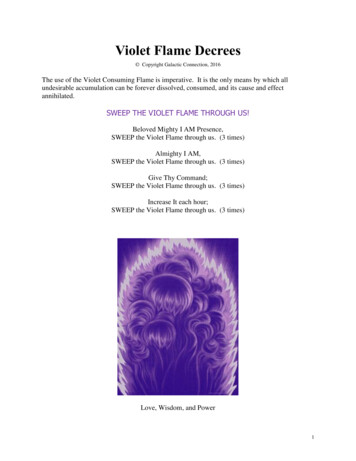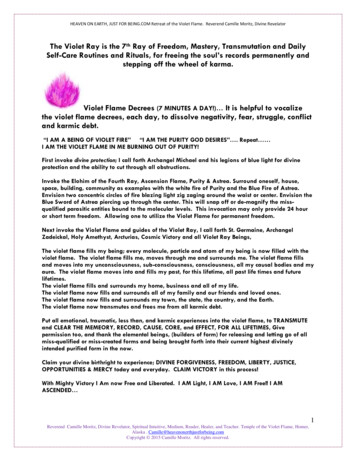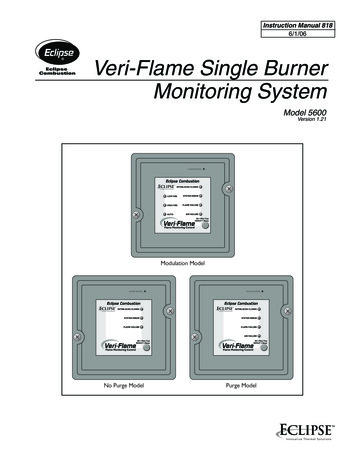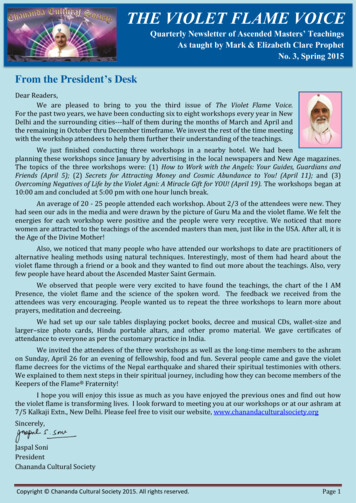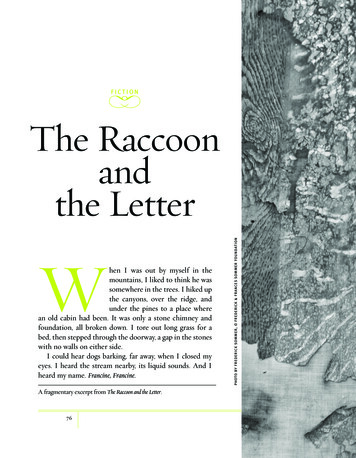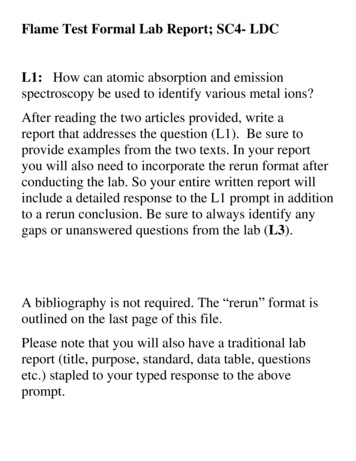
Transcription
Flame Test Formal Lab Report; SC4- LDCL1: How can atomic absorption and emissionspectroscopy be used to identify various metal ions?After reading the two articles provided, write areport that addresses the question (L1). Be sure toprovide examples from the two texts. In your reportyou will also need to incorporate the rerun format afterconducting the lab. So your entire written report willinclude a detailed response to the L1 prompt in additionto a rerun conclusion. Be sure to always identify anygaps or unanswered questions from the lab (L3).A bibliography is not required. The “rerun” format isoutlined on the last page of this file.Please note that you will also have a traditional labreport (title, purpose, standard, data table, questionsetc.) stapled to your typed response to the aboveprompt.
Article #1- The Mysterious Mr. Biv.Lexile: 880LPublication: Odyssey(Dec2007)Author: Cox, Mary BethSir Isaac Newton was the first to make Mr. Biv's acquaintance. The two met in the year 1666. Newton's mostfamous discovery, that gravity causes apples to fall and moons to orbit, was still two decades in the future. In1666, Newton experimented not with gravity but with light.Sir Isaac discovered that a crystal prism separates a beam of white sunlight into a band of many colors. Thecolors fan out in a regular pattern: first red, then orange, yellow, green, blue, indigo, and finally violet. Thepattern spells a name: Roy G. Biv.At first glance, it seemed innocent enough. Mr. Biv was a rainbow, more or less. But hidden from Newton'sinquisitive gaze was a dark secret — a secret that would embroil Mr. Biv in a great scientific mystery.The trouble started in 1814. An employee of the Munich Philosophical Instrument Company, Joseph vonFraunhofer, had his own fateful encounter with Mr. Biv. Fraunhofer specialized in the manufacturing of qualityoptical glass. In the course of his duties, Herr Fraunhofer discovered something unsettling about Mr. Biv. Thecompany's high-resolution optics didn't spread sunlight into the unbroken spectrum Sir Isaac observed. Rather,dark lines repeatedly interrupted the colors. Fraunhofer had stumbled upon Mr. Biv's secret! Hundreds of slicesof color were missing from the Sun's spectrum! Fraunhofer was flabbergasted. He couldn't fathom a reason forthose dark lines. Sadly, he never would. Fraunhofer died prematurely of tuberculosis at age 39. He left themystery of the missing colors unsolved and his questions about Mr. Biv unanswered.The amazing truth wouldn't be known until 1859. Two chemists, Robert Bunsen and Gustav Kirchhoff finallyexposed Mr. Biv's true character. Bunsen and Kirchhoff ran a business selling samples of chemical elements toresearch scientists. To check the purity of their wares, they used a "flame test." They heated their samples in aflame. The color of the flame helped them identify the elements in the sample. Sodium turned the flame yellow.Potassium turned the flame violet. Lithium turned it red, and so on.Bunsen improved the business by enhancing the flame test. First, he developed the famous "Bunsen burner,"now used in school labs worldwide. The Bunsen burner produced a clean, clear, almost colorless flame perfectfor identifying elements. Then Bunsen borrowed an idea from Sir Isaac. He directed the light from flame teststhrough a prism, just as Newton had done with sunbeams. The results were nothing short of revolutionary.Bunsen discovered that the flames weren't just one color. Like sunlight, they were actually a blend of colors.The prism separated the light from flame tests into sharp, distinct colored lines. Each element had a uniqueflame spectrum, much like its own colored line fingerprint. As with any suspect, the fingerprint identified theelement beyond question. This method of using light to make identifications became known as spectroscogy.Gustav Kirchhoff proved what a powerful tool spectroscopy could be. Kirchhoff became an expert atidentifying elements by their spectra. And he discovered two previously unknown elements by detectingunusual patterns of colored lines. One element he named rubidium from the Latin word for "red" and the othercesium from the Latin word for "sky blue."
Kirchhoff had heard rumors of the mysterious Mr. Biv. He decided to examine the dark lines in the Sun'sspectrum himself. To his amazement, he found that the Sun's dark lines exactly matched the flame spectra ofelements. The elements' fingerprints slid into the Sun's dark lines just like pieces of a puzzle. Kirchhoff hadfound the slices of missing color!It was then that Gustav Kirchhoff had a stroke of inspired genius. He realized that the mysterious dark lines andthe colorful fingerprints were two sides of the same coin. When exposed to a flame, elements release coloredlight. But, under more extreme conditions like those in the Sun, the very same elements absorb colors.Elements suck their signature fingerprint colors right out of the Sun's spectrum. Mr. Biv's missing colors areevidence that the Sun and Earth are made of the same stuff. Like Sir Isaac's gravity, elements are everywhere inthe universe.To this day, Mr. Biv's mystery has had lasting consequences. Spectroscopy is an important tool forastronomers, who use it to glean information from the light of stars, planets, galaxies, and nebulae too far awayto ever be visited. NASA has four Great Orbiting Observatories that monitor light in space. The Hubble SpaceTelescope observes visible light — the very same colors that Roy G. Biv represents. The other threeobservatories watch for light not seen by the human eye. The Spitzer Space Telescope observes the infraredspectrum, which includes the invisible colors before Roy. The Compton Gamma Ray Observatory and theChandra X-ray Observatory handle the other end of the light spectrum, which includes the invisible colors afterBiv.Spectroscopy is also used by chemists for research, in manufacturing, and to test the environment. But don'tthink that chemists have completely yielded the skies to astronomers. At the end of this very month, you mightwitness a few breathtaking flame tests in the night sky. Most people call them fireworks. Excited by the energyof a detonation, the elements in fireworks pour forth their fingerprint colors at high altitude. It's celebratoryspectroscopy. To know which element glows what color, you only have to remember one name: Roy(strontium, calcium, sodium) G. (barium) Bi (copper) v (copper strontium).Article #2
Article #2- Principle of Atomic Absorption /Emission Spectroscopy- Flame Test Lab LDC5.1 ATOMIC EMISSION-THE FLAME TESTWhen a small amount of a solution of a metal ion is placed in the flame of a Bunsen burner, the flame turns a colorthat is characteristic of the metal ion. A sodium solution gives a yellow color, a potassium solution results in a violetcolor, a copper solution gives a green color, etc. Such an experiment, called the flame test, has been used in conjunctionwith other tests in many qualitative analysis schemes for metal ions. Whatever color our eye perceives indicates whatmetal ion is present. When more than one metal ion is present, viewing the flame through a colored glass filter can helpmask any interference. Figure 1 shows this experiment.The phenomenon just described is an "atomic emission" phenomenon. This statement may seem inappropriate, since itis a solution of metal ions (and not atoms) that is tested. The reason for calling it atomic emission lies in the processoccurring in the flame. One of the steps of the process is an atomization step. That is, the flame converts the metal ionsinto atoms. When a solution of sodium chloride is placed in a flame, for example, the solvent evaporates, leaving behindsolid crystalline sodium chloride. This evaporation is then followed by the dissociation of the sodium chloride crystals intoindividual ground state atoms -a process that is termed atomization. Thus sodium atoms are actually present in the flameat this point rather than sodium ions, and the process of light emission actually involves these atoms rather than the ions.Figure 1. The flame test: observation of the flame color (a) without colored glass and (b) through prismNa evaporationCl-ofsolvent NaClatomization NaClexcitation of metal atomsNa *drop back to ground stateFigure 2. The sequence of events occurring in the flame testNalight emission
As with fluorescence, the atomic emission is a result of electrons dropping from an excited state to lower states. Thedifference is that (1) atoms are involved here, rather than molecules, and (2) light is not absorbed prior to thisatomic emission. Following atomization, a small percentage of the atoms absorb sufficient energy from the flame (asopposed to a light beam) so as to be promoted to an excited state. As with molecules in fluorescence, these atoms quicklyreturn to a lower state, and light corresponding to the energy that is lost in the process is generated. It is this light thatour eye perceives. The complete sequence of events is depicted in Figures 2 and 3.The discussion of the facts regarding atomic energy levels and molecular energy levels presented in the previousthree chapters is applicable here. Since there are no vibrational levels in atoms, the energy of emission is a discreteamount of energy corresponding to the difference between two electronic levels. Also, since there are usually a numberof electronic levels to which an electron in an atom can be promoted, there are a number of possible discrete energyjumps back to the lower energy states. These represent a number of distinct wavelengths of light to be emitted. Whatis actually emitted by the atoms in a flame is then a line emission spectrum as indicated in Figure 4. (Compare withFigures 10 and 11 in Chapter 12). Figure 5 depicts an explanation of the atomic emission phenomenon. When atoms fallback to lower energy states following the absorption of energy from a flame, a line spectrum is emitted which our eyeperceives as a particular color of light. Each kind of atom is different in terms of the separation between energy levelsand the line emission spectra are therefore different. Because of this, different elements are found to emit thedifferent colors noted earlier.Figure 4. The atomic emission phenomenon: (a)Allowedenergy jumps back to lower levels. (b) A line hetheemittedlightjumps
Flame Test Formal Lab; SC4(LDC Module #1)Chemists began studying colored flames in the 18th century and soon used "flame tests" todistinguish between some elements. Various elements burn with different colored flames. Thepurpose of this lab is to investigate atomic absorption and emission spectroscopy through the use offlame tests. Although some of the flames you will be seeing will appear similar in color, their lightcan be resolved (separated) with a prism into distinctly different bands of colors on theelectromagnetic spectrum (ROYGBIV). These bands of colors are called atomic line spectra, andthey are UNIQUE to each element. Niels Bohr studied the line spectrum for hydrogen, andwondered what the specific line spectrum had to do with the structure of the atom. He postulatedthat an electron can have only specific energy values in an atom, which are called energy levels.Bohr believed that the energy levels for electrons were quantized, meaning that only certain,specific energy levels were possible. How does an electron move between energy levels? By gainingthe right amount of energy, an electron can move, or undergo a transition, from one energy levelto the next. We can explain the emission of the light by atoms to give the line spectrum like this:1. An electron in a high energy level (excited state) undergoes a transition to a low energylevel (ground state).2. In this process, the electron loses energy, which is emitted as a photon (a particle whichbehaves like a wave)3. The energy difference between the high energy level and the low energy level is related tothe frequency (color) of the emitted light.Pre-lab questions:1. Bohr's important discovery was that energy levels of electrons are quantized (only existing incertain, specific levels). In what year was this discovery made?2. What happens to an electron when energy is added?3. What is released when an electron loses energy?4. What determines the frequency (color) of photons?5. Why do you think the frequencies (color) for a specific element is always the same?Procedure: In this lab, you will be observing the colors of the flames for 9 different elements:lithium, zinc, cobalt, sodium, potassium, calcium, strontium, barium, and copper. Each elementis dissolved in a solution of its chloride salt. There is a different solution at each lab station. Youwill go around to all 9, perform the flame test, and make CAREFUL observations of the colors. Youwill then be given an unknown solution, for which you will have to use your notes below todetermine which unknown you were given.
Data Table #1:Metal Name(salt formula)Description of CrystalsObserved FlameColorCalcium (CaCl2)Sodium (NaCl)Cobalt(II) (CoCl2)Lithium (LiCl)Copper (CuCl2)Potassium (KCl)Strontium (SrCl2)Zinc (ZnCl2 )Barium (if available)Unknown #1Unknown #2Post- Lab Questions:1. If you had 2 colors that seemed identical, how could you tell them apart more accurately?2. Albert Einstein determined this equation:energy (in joules) of a photon is equal to Planck's constant times the frequency of the light:E h Frequency ( ) has units of 1/sec (which is a Hertz, or Hz) Planck's constant (h) 6.63 x 10-34 J·seca) If the frequency of a red spectrum line is at 1.60 x 1014 Hz, how much energy does each photonof this light have?b) If the frequency of a violet spectrum line is at 2.50 x 1014 Hz, how much energy does eachphoton of this light have?c) On the far ends of the visible spectrum of light, there exists ultraviolet (UV) radiation andinfrared (IR) radiation.- UV radiation is dangerous. UV radiation is located just past violet on the spectrum. IR radiation is harmless. It is located just past red on the spectrum. Based on what you calculated in parts a & b, explain -why- UV is more dangerous than IR:
Use the ideas below to help you create an RERUN outline to draft your conclusion before you type it inparagraph format as part of this formal lab report. This is in addition and incorporated into the L1 writingprompt discussing the two articles.Recall what your group did during this lab (think about the procedures and calculations).Explain why you did this lab and what you were trying to find out (refer to the purpose).Reflect on the lab's meaning and your results (what did you determine) andor was your hypothesis wrong? Why?did it match your hypothesisUncertainty (errors that were in the lab that you could not control or just any errors that you came across duringthis lab that you could fix for the next time you perform the lab). This should be very specific and related to theprocedures. For this lab, reflect on the answer for analysis question #1-5. Think about differences betweengroup’s data, included human error, among other reasons, that would cause our average atomic mass forCandium to be different.New questions or new discoveries (normally you put in at least two) generated from this lab.
Flame Test Formal Lab; SC4 (LDC Module #1) Chemists began studying colored flames in the 18th century and soon used "flame tests" to distinguish between some elements. Various elements burn with different colored flames. The purpose of this lab is to investigate atomic absorption and emission spectroscopy through the use of flame tests.
